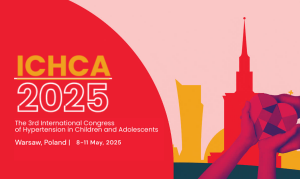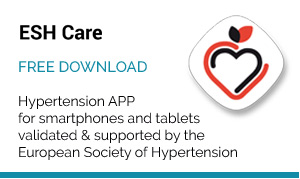Hypertension 2008
In 1994, the European Society of Hypertension (ESH), the European Society of Cardiology (ESC), and theEuropean Atherosclerosis Society published joint recommendations on the prevention of coronary heart disease (CHD). Patients with CHD were deemed a priority and a European survey (EUROASPIRE) was conducted under the auspices of the ESC to assess clinical practice in relation to secondary CHD prevention. This first survey was conducted in nine countries in 1995-96, (1) followed by EUROASPIRE II conducted in 15 countries in 1999-2000 (2) and EUROASPIRE III in 2006-07, in which 22 countries took part.
The initial purpose of the survey was to measure modifiable risk factors and describe their current management. Data from the first two surveys demonstrated a high prevalence of unhealthy lifestyles, modifiable risk factors, and insufficient use of pharmacotherapy to reduce high blood pressure, lipid levels, and blood glucose. Also alarming was increased smoking, particularly among younger patients, and increasing levels of obesity across all centers.
Despite greater understanding of the familial ties that bind in heart disease, EUROASPIRE II found that only one in 10 first-degree relatives of patients with premature CHD were being evaluated for their own cardiovascular risk. Finally, wide variations in preventive practices were seen among centers, likely reflecting differences in economics and health care delivery systems.
EUROASPIRE III evaluated not just hospital patients with CHD and their relatives but, for the first time, healthy individuals receiving primary care and who are at high risk for developing cardiovascular disease. Expanding the survey participants allowed researchers to look at: 1) whether clinicians are following the Joint European Guidelines and 2) whether preventive cardiology practices have improved since the first two surveys were conducted.
Comparing EUROASPIRE Surveys
At Hypertension 2008, Kornelia Kotseva, MD, Imperial College London (UK), presented a comparison of the eight countries that participated in all three EUROASPIRE surveys to describe time trends in lifestyle, risk factor and therapeutic management in European CHD patients (n = 8,547) from 1995-2007. She also discussed whether preventive cardiology practices have improved in the eight countries participating in all three surveys: the Czech Republic, Finland, France, Germany, Hungary, Italy, the Netherlands, and Slovenia.
A positive note from EUROASPIRE III: there has been a significant decrease in total cholesterol (p < 0.0001), which has been cut nearly in half since the first survey. This is likely due to the corresponding seven-fold increase in the use of statins among those surveyed (p < 0.001). Use of other cardiovascular medications has trended upward over time, too, with significantly higher use of antiplatelet agents, ACE inhibitors, angiotensin receptor blockers, and beta-blockers.
Prevalence of elevated blood pressure also is up but only slightly, while therapeutic control is down from the previous surveys. Smoking prevalence has been reduced, but at 18.2% in EUROASPIRE III, nearly one in every five patients continues this very unhealthy habit despite increasing availability of new and effective treatments to help patients stop smoking.
Prevalence of other critical risk factors continue alarming trends, however, over the 12 years of the three surveys. Most problematic: four out of five patients are overweight and obesity (body mass index >/= 30 kg/m2) has increased from a prevalence of 25% in EUROASPIRE I to 38% in the third survey. Waistlines are bulging more, too, with central obesity (a waist circumference >/= 102 cm in men or >/= 88 cm in women) up significantly (p < 0.0001).
These adverse trends among patients with established coronary artery disease reflects what’s happening in the general population in terms of body weight and distribution. This is all contributing to a worsening of other risk factors, such as raised blood pressure, dyslipidemia, and diabetes.
For example, while the increase in diabetes between the first two surveys was negligible, prevalence jumped nearly 8 percentage points in EUROASPIRE III, for a 40% increase over the second survey (p = 0.02). This is hardly surprising given a significant decrease in therapeutic control of diabetes in the third survey: while approximately 25% of patients demonstrated a fasting glucose level <6.1 mmol/l in each of the first two surveys, only 6.7% of participants in the third survey had a similarly low fasting glucose level.
Overall, Dr. Kotseva noted, lifestyle continues to be a major cause for concern. While use of cardioprotective medications is increased across all surveys, this is clearly not sufficient. “Patients need professional support to make lifestyle changes and manage their risk factors more effectively,” she said. Dr. Kotseva added that this can only be accomplished via a comprehensive multidisciplinary prevention and rehabilitation program that should be made available to all coronary patients.
References:
- [No authors listed] EUROASPIRE. A European Society of Cardiology survey of secondary prevention of coronary heart disease: principal results. EUROASPIRE Study Group. European Action on Secondary Prevention through Intervention to Reduce Events. Eur Heart J. 1997;18:1569-82.
- EUROASPIRE II Study Group. Lifestyle and risk factor management and use of drug therapies in coronary patients from 15 countries; principal results from EUROASPIRE II Euro Heart Survey Programme. Eur Heart J 2001;22:554-72.






